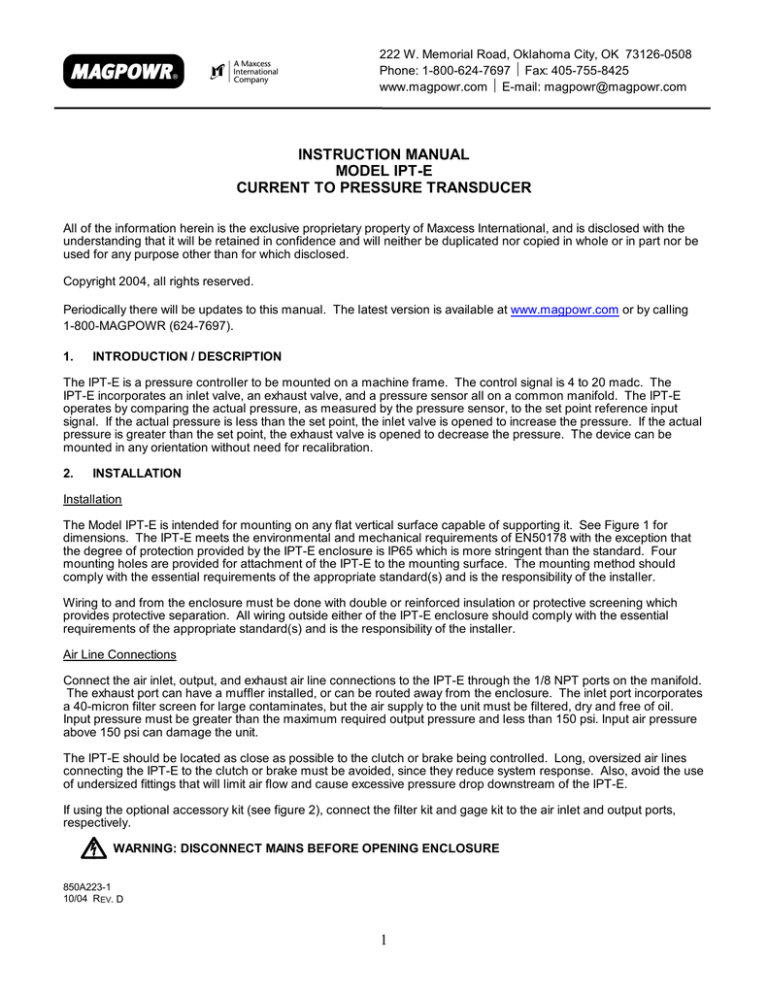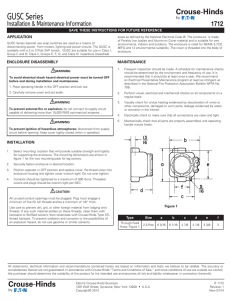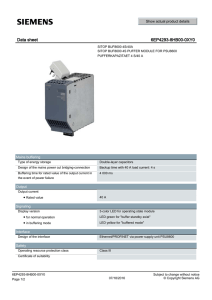
222 W. Memorial Road, Oklahoma City, OK 73126-0508
Phone: 1-800-624-7697 Fax: 405-755-8425
www.magpowr.com E-mail: magpowr@magpowr.com
INSTRUCTION MANUAL
MODEL IPT-E
CURRENT TO PRESSURE TRANSDUCER
All of the information herein is the exclusive proprietary property of Maxcess International, and is disclosed with the
understanding that it will be retained in confidence and will neither be duplicated nor copied in whole or in part nor be
used for any purpose other than for which disclosed.
Copyright 2004, all rights reserved.
Periodically there will be updates to this manual. The latest version is available at www.magpowr.com or by calling
1-800-MAGPOWR (624-7697).
1.
INTRODUCTION / DESCRIPTION
The IPT-E is a pressure controller to be mounted on a machine frame. The control signal is 4 to 20 madc. The
IPT-E incorporates an inlet valve, an exhaust valve, and a pressure sensor all on a common manifold. The IPT-E
operates by comparing the actual pressure, as measured by the pressure sensor, to the set point reference input
signal. If the actual pressure is less than the set point, the inlet valve is opened to increase the pressure. If the actual
pressure is greater than the set point, the exhaust valve is opened to decrease the pressure. The device can be
mounted in any orientation without need for recalibration.
2.
INSTALLATION
Installation
The Model IPT-E is intended for mounting on any flat vertical surface capable of supporting it. See Figure 1 for
dimensions. The IPT-E meets the environmental and mechanical requirements of EN50178 with the exception that
the degree of protection provided by the IPT-E enclosure is IP65 which is more stringent than the standard. Four
mounting holes are provided for attachment of the IPT-E to the mounting surface. The mounting method should
comply with the essential requirements of the appropriate standard(s) and is the responsibility of the installer.
Wiring to and from the enclosure must be done with double or reinforced insulation or protective screening which
provides protective separation. All wiring outside either of the IPT-E enclosure should comply with the essential
requirements of the appropriate standard(s) and is the responsibility of the installer.
Air Line Connections
Connect the air inlet, output, and exhaust air line connections to the IPT-E through the 1/8 NPT ports on the manifold.
The exhaust port can have a muffler installed, or can be routed away from the enclosure. The inlet port incorporates
a 40-micron filter screen for large contaminates, but the air supply to the unit must be filtered, dry and free of oil.
Input pressure must be greater than the maximum required output pressure and less than 150 psi. Input air pressure
above 150 psi can damage the unit.
The IPT-E should be located as close as possible to the clutch or brake being controlled. Long, oversized air lines
connecting the IPT-E to the clutch or brake must be avoided, since they reduce system response. Also, avoid the use
of undersized fittings that will limit air flow and cause excessive pressure drop downstream of the IPT-E.
If using the optional accessory kit (see figure 2), connect the filter kit and gage kit to the air inlet and output ports,
respectively.
WARNING: DISCONNECT MAINS BEFORE OPENING ENCLOSURE
850A223-1
10/04 REV. D
1
Maintenance
The only maintenance that may be required on the IPT-E is fuse replacement. Replacement of any fuse requires
opening the enclosure, which circumvents the enclosure IP rating. To replace a fuse:
1.
2.
3.
4.
5.
Disconnect the supply mains.
Remove front cover.
Remove and replace the blown fuse.
Install front cover.
Reconnect supply mains.
3.
ELECTRICAL CONNECTIONS
Figure 3 shows the electrical connections that are required for the IPT-E.
Set SW1 to match the voltage of the AC line, 115 or 230 vac. Connect AC power to terminals ACL1 and ACL2 on
TB1. Connect the control input signal to terminals IN+ and IN- on TB2. Terminal IN- is the lower potential line.
Route AC power away from control wiring. Run all wiring in shielded cable. Connect shields to the enclosure using
the standoffs provided. Maximum shield length and maximum length of wires outside of the shield is 3 inches
(75mm). The larger strain relief accepts a .28 to .47 in. diameter cable. The smaller strain relief accepts a .16 to .31
in. diameter cable.
4.
TROUBLE SHOOTING
PROBLEM
POSSIBLE CAUSE
SOLUTION OR DIAGNOSTIC
No pressure output
No AC power.
Wrong AC voltage.
No signal input.
Connect AC power.
Check voltage and set SW1 to 115 or
230vac.
Connect 4-20madc to TB2.
No air source connected.
Connect air source to the air in port.
IPT-E SPECIFICATIONS
Supply Voltage:
Supply Frequency:
Fuses:
F1, F2
Enclosure:
Climate Class:
Temperature Range:
Operating (TB)
Storage
Relative Humidity:
Pollution Degree:
Altitude:
Compatible Residual
Current Devise Types:
Worst Case Fault Current:
Inputs:
Signal Input
Pressure:
Maximum Input Pressure (PB):
Volume (V):
115 or 230 vac, ±10%
50 or 60 Hz.
1.6 amp, Littelfuse Part No. 21601.6, or
Wickmann Part No. 19194-053-FS
IP65 (IEC529)
3K3 (EN60721)
0°C to 40°C
-30°C to +80°C
5% to 85%
2 (IEC664-1)
0 to 2000 meters
A or B (IEC755)
1.6 amperes
4 to 20 madc, 249Ω input impedance
0 to 80 psig (0 to 5.5 bar)
150 psig (10.3 bar)
0.02L
2
Figure 1
Figure 2
3
Figure 3


